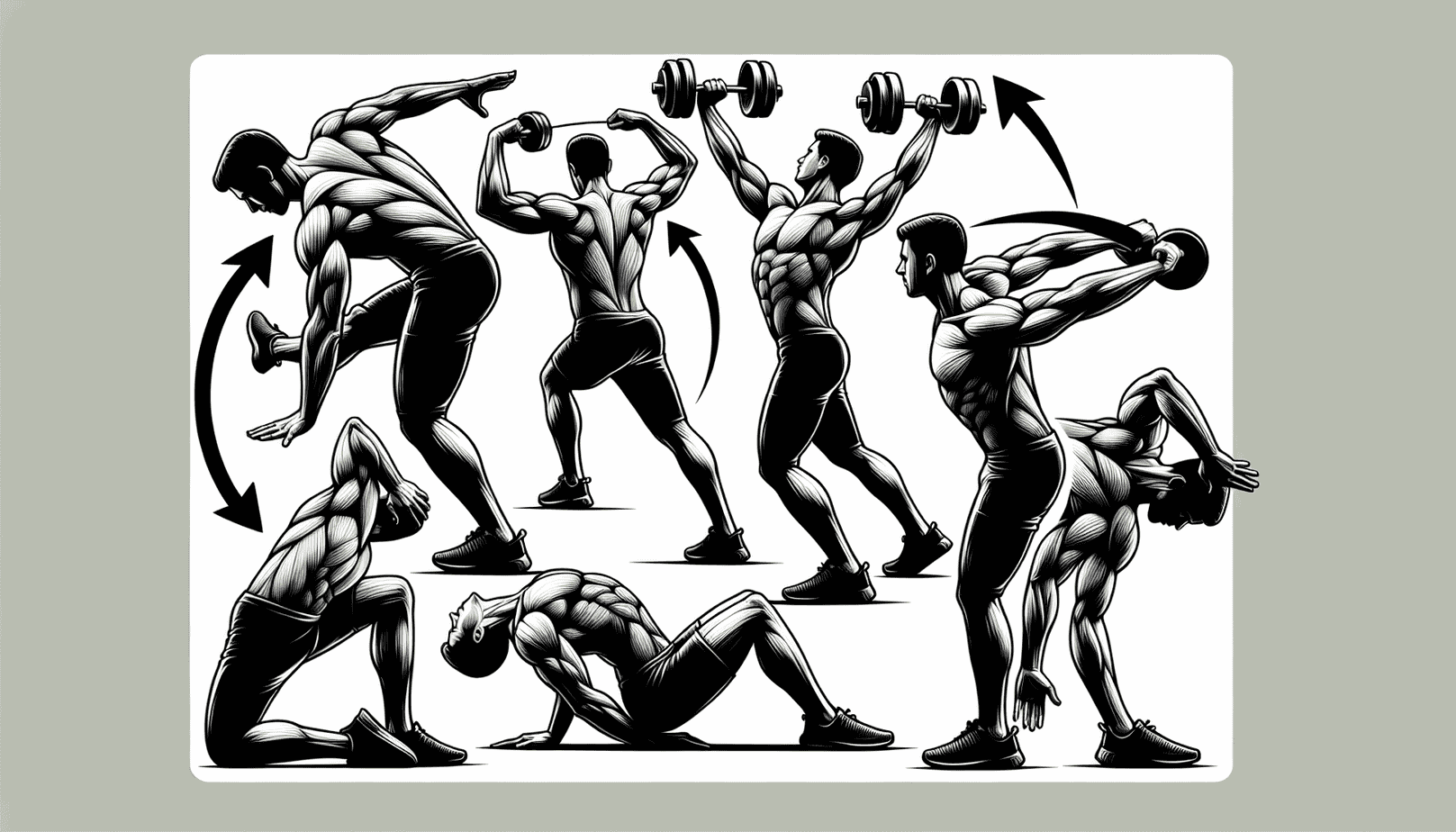What if your workout could directly improve how you function day-to-day? That’s the core of functional fitness – a training approach designed to make everyday activities easier and reduce your risk of injury.
By focusing on natural movement patterns, functional fitness prepares your body for daily tasks, whether it’s carrying groceries, playing with your kids, or performing well in sports. Dive into this article to discover how functional fitness can fit into your life, offering practical workout strategies that cater to all levels of fitness.
Key Takeaways
-
Functional fitness focuses on preparing the body for real-life activities and movements, emphasizing multi-joint movements to enhance balance, coordination, flexibility, muscle strength, and agility, leading to easier daily tasks, reduced injury risk, and improved quality of life.
-
A functional fitness routine should be tailored to an individual’s daily life, engaging multiple muscle groups and incorporating core-strength exercises for enhanced stability and health, with a progressive increase in intensity for continuous improvement.
-
Diverse functional fitness workouts, including bodyweight exercises and those utilizing equipment like kettlebells and resistance bands, improve real-world strength and coordination, while functional fitness classes offer community support and motivation.
Exploring Functional Fitness: Beyond the Gym

Functional fitness operates on a straightforward principle: train your body to cope with real-life situations. This method extends beyond the gym, honing your capacity to execute daily tasks and activities effortlessly.
This is achieved by building a body capable of doing real-life activities in real-life positions. It’s not about lifting the heaviest weights or running the fastest mile, but about training your body to work more efficiently and effectively in your day-to-day life.
Functional fitness training involves multi-joint movements that engage several body parts such as:
-
knees
-
hips
-
spine
-
elbows
-
wrists
-
shoulders
This type of training prepares the body for real-life activities like bending, twisting, and lifting, thereby upgrading life as a whole, making routine tasks easier, reducing injury risk, and enhancing quality of life.
Defining Functional Fitness Training
Functional fitness training is not your typical workout routine. Its exercises are designed to train muscles for everyday activities, enhancing:
-
strength
-
conditioning
-
posture
-
stability
-
flexibility
The aim is to improve these aspects by teaching the body to move with proper form. This can be achieved through targeted training and practice.
Functional fitness enhances overall mobility and supports improved completion of daily tasks by boosting:
-
Balance
-
Coordination
-
Flexibility
-
Muscle strength
-
Agility
Moreover, it reduces the risk of injury by promoting musculoskeletal strength and can assist in injury rehabilitation by restoring movement patterns and strengthening muscles.
The Essence of Functional Movements
In fitness, functional movements aim to mimic and prepare the body for real-life activities. They enhance strength, flexibility, balance, and coordination.
These exercises use multiple joints and muscles at once, focusing on mobility and stability. For instance, specific workouts might incorporate functional movements like squat-to-shoulder presses and lunge-to-shoulder presses with dumbbells or kettlebells, effectively training the body for actions like lifting and reaching.
Functional fitness workouts, which emphasize bodyweight exercises, enhance coordination and minimize the risk of injury, thereby providing a safe and effective choice for individuals at different fitness levels.
Functional Fitness vs. Traditional Workouts
Functional fitness is not about isolating muscle groups or gaining muscle mass; it’s about using the entire body to maximize physical potential. This approach contrasts with traditional weight training, which often isolates muscle groups through machine-based exercises.
Unlike weight training which centers around lifting weights to build muscle mass and strength, functional fitness emphasizes movements that are akin to everyday tasks. It stresses the importance of practical strength and conditioning for daily life, diverging from bodybuilding, which is primarily concerned with performance and appearance on stage.
Crafting Your Functional Fitness Routine

Having grasped the concept of functional fitness, the next question is: how do you tailor a routine to your lifestyle?
The first step is to assess your daily activities. This process helps you identify which muscles are most often used and any potential physical limitations that need to be considered.
After this initial assessment, you can select exercises that target and strengthen the muscles involved in those activities. This approach enhances your functional fitness, allowing you to perform daily tasks and activities with increased ease and efficiency.
Tailoring Exercises to Your Daily Life

Select functional exercises that mirror routine daily activities like lifting, bending, walking, and reaching.
For instance, exercises like the Lateral Shuffle Bar Pickup train for motions like picking objects up from the ground; lunges with a shoulder press help with reaching for high shelves; and squats and lunges assist with actions like gardening and getting up from a chair.
Functional exercises have several benefits:
-
They can be adjusted to suit different individual fitness levels
-
They can simultaneously engage multiple muscle groups
-
This allows each person to train at their own pace
-
It gradually improves strength and endurance over time
Building Core Strength for Stability and Health

It’s vital for functional fitness routines to engage core muscles extensively, fostering enhanced core strength, stability, and posture. Core-focused exercises such as planks, bridges, and single-leg stands are fundamental to functional fitness as they enhance alignment, stability, and mobility.
Exercises such as the bodyweight squat, single-leg deadlift, and straight-leg sit-up can enhance core strength, balance, and full-body stability without the need for any equipment. By emphasizing movements that challenge the core, posture, and balance, functional exercises can improve overall function and prevent injuries.
Progressing Safely in Your Functional Training
The key to a successful functional fitness journey is safe progression. Workouts should be designed to increase in intensity over time through strategies such as:
-
adding weights
-
incorporating variations
-
including a variety of exercises
-
modifying the routine as needed
These strategies help challenge the body, prevent plateauing, and ensure continuous improvement.
Regularly integrating a variety of movements of different intensities into training can avert muscle strains and enhance agility, balance, and strength.
Function fitness workouts should gradually become more intense to safely adapt the body to increased fitness demands.
The Diverse World of Functional Fitness Workouts
Functional fitness training encompasses various types of workouts, including a functional fitness workout. From bodyweight exercises to circuit training and high-intensity interval training (HIIT), these workouts aim to promote functional movement patterns, efficiency, and flexibility.
A diverse range of exercise equipment such as fitness balls, kettlebells, and weights are often incorporated into functional fitness workouts. These tools engage all muscles in the body, adding a new dimension of challenge to your routine and helping you achieve your fitness goals.
Bodyweight Exercises: The Foundation of Functional Training

Bodyweight exercises are the backbone of functional fitness. Some examples of bodyweight exercises include:
-
Pushups
-
Squats
-
Lunges
-
Planks
-
Single-leg deadlifts
-
Straight-leg sit-ups
-
Bulgarian split squats
These exercises build a base level of strength and prepare the body for more complex and challenging movements.
Practicing these exercises not only builds strength but also eliminates the need for gym equipment. This aspect makes functional fitness accessible to everyone, regardless of their access to a gym or workout equipment.
Moreover, HIIT workouts often incorporate bodyweight movements for high-intensity bursts that target multiple muscle groups, enhancing overall functional fitness.
Incorporating Equipment for Enhanced Functional Strength
Once you’ve mastered the foundational bodyweight exercises, you can start incorporating equipment into your workouts. Dumbbells, kettlebells, and resistance bands can enhance the challenge and resistance of your workouts, leading to improved strength development.
Functional workouts can incorporate a variety of tools including:
-
Resistance bands
-
Stability balls
-
Suspension trainers
-
Cable machines
-
Medicine balls
These tools create a diversified challenge that mimics daily life activities and can be used for various exercises aimed at enhancing strength, improving coordination, and increasing aerobic capacity.
Functional Fitness Classes: Community and Motivation
Beyond individual workouts, functional fitness classes offer a multitude of benefits, including:
-
Improved movement patterns
-
Increased calorie burn
-
Enhanced aerobic capacity
-
Maintenance of lean muscle mass
Functional fitness classes are suitable for individuals of different fitness levels and ages. They incorporate various fitness techniques such as circuit training and high-intensity interval training (HIIT).
Regular attendance, around three to four times a week, can lead to noticeable improvements in everyday movements within as short as one month, making these classes a powerful tool in your fitness arsenal.
Real Stories: How Functional Fitness Helps Transform Lives
Functional fitness doesn’t just promise results – it delivers. Real-life stories of transformation abound, from individuals who have surpassed their fitness goals to those who have achieved substantial health improvements.
These stories serve as a testament to the power of functional fitness and its ability to transform lives. They provide compelling evidence of how this approach to fitness can lead to:
-
Enhanced physical performance
-
Increased independence
-
Improved quality of life
From Everyday Struggles to Peak Performance Inside and Out
Functional fitness has helped countless individuals surpass their fitness goals and maintain high fitness levels. For instance, one participant in Functional Fitness boot camps lost 75 pounds and excelled in fitness tests for a career in law enforcement.
Another individual achieved a ‘new’ body, significantly improving health and physical capabilities through Functional Fitness training. Others have been able to maintain high fitness levels and continue running half marathons for seven years with personalized training plans.
Older Adults Achieving Independence
The benefits of functional fitness are not limited to the young or athletic. Older adults, too, have achieved remarkable results. By improving balance and stability, functional fitness is essential for preventing falls and decreasing stiffness in joints and muscles in older adults.
Specifically designed exercises in our exercise program replicate daily activities for the elderly, such as:
-
reaching high shelves
-
getting in and out of a car
-
getting up from a chair
-
walking up and down stairs
These exercises ensure that older adults are equipped to maintain their independence and safety. Regular functional fitness training has enabled an older person to climb six flights of stairs with restored endurance and without excessive fatigue.
Another senior citizen has experienced considerable improvements, including better walking ability, regained height, and improved condition, manifesting in more independence and confidence.
Integrating Functional Fitness into Your Lifestyle
Functional fitness exercises can be seamlessly included in daily activities to aid in tasks like climbing stairs, reaching for objects, or picking up dropped items thanks to improved mobility, strength, and balance.
Incorporating functional movements into daily activities can be accomplished in various environments, such as at home, in the park, or even in small spaces with limited equipment.
Practicing basic workouts that target all muscle groups and can be completed anywhere, such as:
-
bodyweight squats
-
push-ups
-
lunges
-
reverse crunches
-
lifts using a backpack
can make a significant difference.
Desk Job Dilemmas: Functional Fitness for Office Workers
Integrating functional fitness into everyday life can counteract the detrimental health impacts of sedentary habits, such as prolonged sitting, by ameliorating posture and fortifying core strength.
For office workers, ‘The Office Worker’ video series from the Living Functional website includes functional movements that can be integrated into a seated position. These exercises improve circulation and alleviate muscle stiffness, making them a boon for those who spend most of their day at a desk.
Functional Fitness on the Go: Staying Fit While Traveling
Being on the move doesn’t necessitate a hiatus from fitness. By identifying core functional movements that can be performed with body weight alone, such as squats, lunges, and push-ups, you can maintain fitness while on the move.
Utilize small spaces in hotel rooms or outdoors for short, high-intensity interval training (HIIT) workouts to conserve time and space.
You can also incorporate physical activities such as walking or biking into your sightseeing plans, turning exploration into an opportunity for functional exercise.
Making Functional Fitness Family-Friendly
Functional fitness is adaptable to encompass family activities, nurturing a culture of health and activity at home. Children and adults can perform functional movements together as these activities can reflect routine tasks and can be practiced by all age groups.
Gamification of functional movements, such as turning exercises into competitive games, can make these activities more engaging for the whole family. Incorporating functional fitness into family life not only supports health but also strengthens family bonds through shared activities.
Summary
Functional fitness is not just a workout routine; it’s a lifestyle. It’s about training your body to handle real-life situations, improving your strength, flexibility, and coordination.
Whether you’re an office worker, a traveler, or looking for family-friendly activities, functional fitness can be seamlessly integrated into your daily life.
By focusing on functional movements that mimic everyday tasks, this approach to fitness can help you achieve your fitness goals, enhance your physical performance, and even improve your quality of life.
Whether you’re just starting your fitness journey or looking for a new challenge, functional fitness could be the key to unlocking your full potential.
Frequently Asked Questions
What is meant by functional fitness?
Functional fitness refers to exercises that mimic everyday movements like walking, bending, or reaching, improving overall strength and mobility for daily activities. It’s designed to support and enhance your everyday movements.
How can I incorporate functional fitness into my daily routine?
Incorporate functional fitness into your daily routine by choosing exercises that mimic common daily activities such as lifting, bending, walking, and reaching. mimicking everyday activities can help improve your strength and mobility.
What are some examples of functional fitness exercises?
Functional fitness exercises include pushups, squats, lunges, planks, single-leg deadlifts, and straight-leg sit-ups. These exercises are designed to improve strength, balance, and flexibility in everyday movements, making them a great addition to any workout routine.
Can I practice functional fitness while traveling?
Yes, you can continue your fitness routine while traveling by doing body weight exercises like squats, lunges, and push-ups. High-intensity interval training (HIIT) can also be done in small spaces.
How does functional fitness benefit older adults?
Functional fitness benefits older adults by improving balance, stability, and mobility, which can help prevent falls and promote independence in daily activities. Specifically designed exercises are essential for maintaining physical well-being and safety in older adults.
